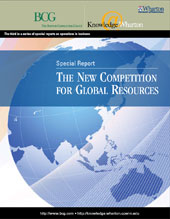According to Hal Sirkin, senior partner and managing director at The Boston Consulting Group, “The age of globalization is over.” In its place is a new reality that Sirkin and BCG colleagues Jim Hemerling and Arindam Bhattacharya define in their recently published book, GLOBALITY: Competing with Everyone from Everywhere for Everything. In an interview with Knowledge at Wharton, Sirkin describes how rapidly developing economies like India and China have changed global business from a “one-way street” benefitting Western multinationals to a two-way competition in which “blending the best of the East with the best of the West is most likely the winning formula.”
The following is an edited transcript of the conversation:
Knowledge at Wharton: You call your book Globality, but isn’t it really about globalization?
Sirkin: The one thing we have found is that the age of globalization is actually over. Globalization was a one-way street. It was about the companies from the U.S. and Europe, and then later on Japan, going to the rapidly developing economies with large populations and very low wage rates and either producing product or buying product, shipping it back to the developed markets, and then shipping over some very high-end and often luxury goods to those markets. So, it was fundamentally a one-way street.
What has changed over the last few years with the rise of China, India, Russia, Eastern Europe and Brazil is the emergence of a two-way street. What we have seen over the last five years is not just companies from the West coming to India and China, etc., but companies from India, China, Russia and Brazil becoming real companies that are not just operating in their local markets, but are actually taking their rightful place on the global stage. And, in doing so, they are starting to challenge the traditional multinational companies.
Now, it’s a two-way street and a competition. That means that companies from India, like Tata, or companies from China, like Baosteel, play on the global stage, and compete with the Western companies. That’s globality. It’s about lifting up 15% to 20% of the world’s population that’s trying to get enough food to get through the day and having them become part of the consumer society.
Knowledge at Wharton: What is the “Triple E” threat and what are some of the ways in which it manifests itself?
Sirkin: We’re talking about the need to compete with everyone, from everywhere, for everything. It’s a threat to companies that don’t understand it because those companies from the developing countries have a set of advantages. You may overlook them as potential competitors, but they are starting to show up in the U.S., in Europe and in Japan.
They’re starting to build positions that could threaten the traditional multinationals. But of course, the flip side of a threat is an opportunity. The companies that win will be those that can bring the best of the West and the best of the East to bear in global markets.
Knowledge at Wharton: I wonder if you could explain a little bit more about your concept of globality and how does it differ say from Thomas Friedman’s ideas about the world being increasingly flat?
Sirkin: We don’t think that the world is flat at all. We think that the world is very spiky. Thomas Friedman wrote a great book that really awakened people to the changes that are taking place in the world. And, it’s a wonderful title: The World Is Flat. But the reality is that the world is very spiky and that’s precisely why this is happening. If the world had the same wage rates everywhere, we wouldn’t be seeing the rise of globality. If the world had the same capabilities everywhere, we wouldn’t be seeing it.
Companies that operate in environments with different spikes, such as low-cost labor, are beginning to use those spikes to their advantage. Then they can build on that advantage by investing in research and development, new product development and distribution. And, in the case of companies like Tata, a $25-billion company in India, they buy companies like Jaguar and Corus Steel [formerly an Anglo-Dutch company] in order to build strong positions on those markets. As we see that happening, we see the environment changing.
Knowledge at Wharton: What are the implications for companies in places like India and China? What are the opportunities and threats that globality presents for them?
Sirkin: They face the same opportunities and threats in many ways as the Western companies. Companies that operate in an environment where wage rates are about $1 an hour and rising at 8% a year have a tremendous advantage relative to companies in the U.S., where wages are $25 an hour and growing at 2.5% a year, or Germany, where wages are about $50 an hour with the Euro now approaching $1.60. They can use that advantage.
But if they sit back and just stay local, they’ll end up losing the advantage over time, because companies compete on more than just wages. If you want to produce a low-end product, you can do it that way. But you’ll need to step out into other markets to learn about how to bring the best of the rest of the world to bear on your own business.
If you’re not taking a global perspective, your competitors in India or China may come into your market and take your position. The world is going to get much more competitive. To compete, companies must know how to balance things.
Low cost won’t be enough to win, because at this point in time just about anybody can access low cost in China, India or Brazil. So, it’s a great way to start because $1 versus $25 — all else [being] equal — you know which one will win. But over time, everybody will have access to lower costs.
Knowledge at Wharton: So, if that’s the case, what are the implications for companies in more mature markets? What should be their strategy to globalize?
Sirkin: It’s about picking the right locations, but it’s more than just going to those countries, acquiring low cost labor, producing things and exporting them. If you look at the population in India, there are about 1.1 billion people. China has about 1.3 or 1.4 billion people. So, we’re talking about 2.5 billion people. Those are huge markets. And if you look at the rapidly developing economies overall, there are about 3.5 billion people.
We think that over the next 20 years, another billion consumers will move from abject poverty and enter the consumer market. That means a lot of opportunities for consumer products, but also for companies that make things for businesses that sell to those consumers.
Recognize that a billion people is more than the combined population of the U.S., Western Europe and Japan. It is a huge opportunity…. If you sit in Chicago or Philadelphia or Paris or Frankfurt and ignore a billion-person market, you’ll regret that you missed that opportunity.
Knowledge at Wharton: Do you see any companies that haven’t missed it and who actually are pursuing creative strategies to access that billion-person market?
Sirkin: A lot of companies are doing that. Perhaps one of the best examples is Nokia, the Scandinavian manufacturer of cellular telephones. They built a position in China in the early days, by selling the traditional way — by offering a higher-cost Western product. When cell phone demand was really low and only the super-rich could afford them, that wasn’t really an issue.
However, a bunch of local companies came in and started producing cell phones at a much lower cost. The demand increased and Nokia started to lose market share. And of course, those local cell phone companies started to move up the value chain and started to attack Nokia’s traditional high-end market. The conventional response might have been to retreat.
But Nokia was much smarter than that and said, “No, I have to stand my ground here and fight for the customer.” They rethought their product development, moved it to China, and changed their phones to better meet the needs of the Chinese consumer. They also found a way to produce a high quality product at a much lower cost.
Nokia also changed its third-party distribution system, recognizing that when it came to sales and understanding customers — particularly the retailers — they had to be there themselves with their own people. Nokia’s market share, which had dipped to the low teens, is now back up around 30% because they stood their ground and adjusted their approach to the market.
This gave Nokia an incredible learning experience. They now understand how to operate in rapidly developing economies such as China. The lesson is: You have to be there, you have to learn, and retreat is not an option.
Knowledge at Wharton: How much does this erode the competitive advantage of emerging challengers from these countries, when multinational companies set up operations there?
Sirkin: It’s always easier when you start from a place to understand what it takes to operate there, just as it’s hard for Chinese companies to come to the U.S. and operate. So even if you hire local people, there’s a huge gap between the corporate center, which may be again in Philadelphia, and the operations, which may be in Bangalore. That’s a real disadvantage.
Now the Western companies have the advantage, so the advantage of the emerging local company is reduced. But the smart local company will learn from Western companies and begin competing with them by selling in Philadelphia, Los Angeles and Paris.
And again, it will become a significant battle. That’s why we think globality is about competing with everyone, from everywhere, for everything.
Knowledge at Wharton: So, it will balance out eventually.
Sirkin: It will balance out because there will be competitive dynamics…. Losers and winners will come from the rapidly developing economies as well as the developed countries. A new equilibrium will eventually settle in, but it will be a long time before that happens because a lot of change will take place first.
The fundamental inflation we’re seeing now with the prices of oil , raw materials and food — this is what we mean by competing with everyone from everywhere for everything. Historically, competition was about product, but now it’s for resources and human capital. We see this in India, where a competitor hires away your talented new people after six months — for a lot more money. There is a huge competition for human resources.
There will be massive competition for raw materials and we’re seeing increasing competition for intellectual capital. So the basis of competition that this new equilibrium is starting to create is also different. And you have to start thinking about the pricing and sourcing of all these things. They’re not commodities at this point in time, but all of these [are] important ingredients to run your company in a very different way.
Knowledge at Wharton: You referred to the fact that there will be winners and losers, both among the challengers as well as among the incumbents. What separates the winners from the losers and how can you ensure that you don’t become a loser?
Sirkin: You can ever ensure it, but it’s about changing the odds. It requires a willingness to understand the other paradigm. If you take a U.S.-centric perspective, then you’ll get one solution. If you go to India, you’ll get a different solution. The way to increase the odds of success is to blend those two perspectives together. The “best of the East and the best of the West” is most likely the winning formula.
In our book we call it pinpointing, which is deciding what you’ll do where…. I look at an Indian company like Bharat Forge in Pune, India, which is the third-largest manufacturer of forgings in the world. They’ve made some very important decisions and they just don’t focus on low cost. They’ve made acquisitions in Germany, in China and in different parts of the world to get closer to the customer and to access technology.
They’re blending the best of the East and the West and saying, “I’m okay being a high-cost competitor in some places because it’s worth it. I can charge the right price and learn the right skills. I don’t have to be just a low-cost competitor.” And they’ve done an excellent job of blending who they are.
Again, if you sit in a corporate center and don’t see that, then get ready to lose. Or if you’re in a developing economy and want to play on the global stage, you’d better be thinking about how to compete effectively in the developed markets. It’s the blend that will probably win.
Knowledge at Wharton: Isn’t it also true that some lessons are easier to learn than others? And I’ll tell you what I mean: If you take companies like IBM or Accenture, they’ve set up big operations in India now for their IT practices. They have hundreds of thousands of employees there. So in that sense, you’re absolutely right that they are able to match the low-cost operations of companies like Infosys or Wipro or TCS.
On the other hand, the Indian IT companies like Infosys and Wipro have always had the challenge of developing relationships with customers in the Western countries, which is what the Accenture’s and the IBMs have excelled at. So with that kind of a dynamic, it almost seems easier to me for IBM to create a production back end that can mimic the costs of the Indian challengers, but not that easy for the Indian challengers to develop the customer relationships off of the incumbents. How do you think that dynamic will play out?
Sirkin: One more thing to add to the dynamic is creativity. If you sit in the West, the paradigm that affects your thinking is very different from the one you’d have if you were in India. In the West we have a very traditional engineering mindset that is hard to break out of. If you sit in India or China, the things you don’t know can actually work in your favor.
So if you look at a product like the Tata Nano, the small $2500/1 lakh car, and you asked auto manufacturers in Detroit or Stuttgart, “Is that possible?” they would say, “No, you can’t do that.” Well, the reality is that you can and Tata is proving it. That level of creativity may well be leveling the playing field.
Knowledge at Wharton: You mentioned rising oil prices and the Tata Nano, the emergence of this inexpensive car. What other ways will people — everyday consumers — recognize the emergence of this process outside of business?
Sirkin: We are seeing it in all sorts of places. My son is a junior in high school and I’d certainly love for him to go to Wharton. But his competition is going to be far more fierce than when I applied in 1976. Probably 20% or 30% of the students here were not born in the United States and that will probably go up over time. So as we think about my children’s future — my son is 17 and he is looking at colleges — he’ll be facing a greater level of competition from around the world. So, competing for everything includes competing for the right to go to Wharton.
Knowledge at Wharton: We are all talking about this global slowdown, especially the credit crunch in the U.S. and the mature economies. Does that affect the process of globality at all?
Sirkin: It may speed it up a little bit because there will be more pressure to lower costs, which of course is one of the advantages of operating in developing economies. That may encourage even more Western companies to go beyond their own borders to lower costs, and may also create more opportunities for companies from India, China, Russia and Brazil. It also may mean more outbound M&A from the developing world, which will give the emerging companies access to brands and technology, possibly at lower prices.



